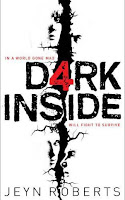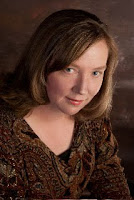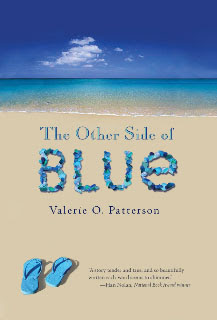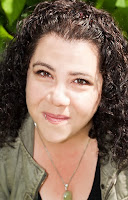
Hi everyone! I’m Jeyn Roberts and I’m the author of Dark Inside.
Almost everything becomes a trend at one point of another. Recently it came in the form of skinny jeans and before that, there was a huge wave of low rise pants. I hated those, my stomach always felt like it was trying to break free.
So fashion follows trends. Movies and music too. Even food has its trendy moments. It’s only natural that books ride down that road too.
I never meant to write a dystopian novel. I didn’t exactly sit down and say ‘hey, dystopian! Cool.’ Actually I was trying to rewrite another story (now dead on my hard drive) and it was the end of November. I’d been teaching in South Korea for two months and I was feeling rather isolated. My friends and family were halfway around the world. I barely spoke the language. I loved my job but my evenings were a little quiet. Too quiet. While going through my notes one night, I came across some pages I’d written years ago based on dreams I used to have.
And then I got sidetracked. Boy, did I get sidetracked. The old story got tossed aside and suddenly I was writing up a storm. I guess in a way I got lucky. The new trend is dystopian and my novel just happened to fall under that genre.
I’ve always loved the whole end-of-the-world story. I’m a big fan of zombie movies and Stephen King’s ‘The Stand’ is still one of my all-time favourites. I’m thrilled to see the amount of dystopian novels on the shelves today. Books like The Hunger Games and Gone have really captured my imagination. I consider myself very lucky that I’m getting to be a part of this whole trend. So much better than skinny jeans if you ask me.
Blog: tall tales & short stories (Login to Add to MyJacketFlap)
JacketFlap tags: The Greenhouse, Cornerstones, SCBWI, Author Interview, debut author, Add a tag
 Hi Jon and welcome. Would you like to tell us a bit about yourself?
Hi Jon and welcome. Would you like to tell us a bit about yourself?
Hi Tracy and thank you so much for inviting me for interview. It really is a pleasure.
I live in the North-West of England with my rather large family and a huge number of chickens, dogs, tortoises… and a cat. I’ve taught English, Drama, History, Life skills, shopping, but I like teaching children most. Music is important to me and I’ve played mandolins and guitars in a few folk and ceilidh bands over the years. My childhood was spent playing in the overgrown ruins of a Victorian zoo so I suppose it’s no surprise the way my stories turn out.
For orphan Josie, life is good with Cardamom, the great magician who took her in as a baby and with whom she now performs her astounding knife-throwing act. But then three mysterious ‘aunts’ turn up - taking over the house and transforming into vicious, giant crows, in thrall to evil Lord Corvis. With his dying breath, Cardamon tells Josie to ‘seek the Amarant - and Mortlock’. So begins a terrifying quest for Josie and her newly discovered twin, Alfie, the undertaker’s mute, who soon realize that the legendary Amarant is a plant with power over life and death, which Cardamon, Corvis and Mortlock first discovered many years ago in Abyssinia.
But Cardamon had another secret and now only the final destruction of the plant can quench Corvis’s growing powers and evil plans. Josie and Alfie will need all their courage and skills to save themselves and the world.
What inspired you to write MORTLOCK and how long did it take you from initial inspiration to finally achieving the publication deal?
I was watching my son in a school production of ‘Oliver’ and when Oliver Twist is ‘sold’ to Mr Sowerberry the undertaker, I remember having one of Sarah’s ‘What if’ moments. What if Oliver as an undertaker’s mute marching behind coffins every day suddenly found he could raise the dead? At that moment, Alfie Wiggins was born. November 2007. So you could say it took two years and five months. Of course everything I had written before led up to that point.
Throughout the book each chapter is separated by a quote from a traditional folk ballad. Did these songs inspire the writing of MORTLOCK in anyway?
The main influence was The Twa Corbies (The Two Ravens) it was such a gory ballad and one I had known of since childhood. In part, it gave me the idea of crows as the monsters for the book. The other ballads formed the fabric of my imaginary world. The songs give me an insight into how people might have thought or lived in the past. In one draft of the book, I had a singer who said that the dead talk to us through the old songs. I suppose I believe that.
MORTL
Blog: tall tales & short stories (Login to Add to MyJacketFlap)
JacketFlap tags: Agent Interview, The Greenhouse, Add a tag
There is a fascinating podcast interview with Julia Churchill of The Greenhouse Literary Agency to be found on the British Isles SCBWI site or on Youtube.
Richard Hagon interviews literary agent Julia Churchill at SCBWI's mini-conference in Lincoln in North East England. October, 2009
Richard Hagon is a freelance performer and entertainer. He writes, performs, and produces radio shows for clients around the world, working largely within the games industry. He has performed with numerous musical theatre groups, and he also writes and directs for the theatre. He has acted as Master of Ceremonies for hundreds of events large and small, and The Storyteller's Story is his latest venture, interviewing writers about their work and lives. For more information, contact [email protected]
It's well worth a listen so please do follow either link.
scbwi-interview-julia churchill
Youtube
The Greenhouse Literary Agency on Youtube
Thanks to Candy Gourlay and Richard Hagon.
Blog: tall tales & short stories (Login to Add to MyJacketFlap)
JacketFlap tags: Author Interview, debut author, The Greenhouse, writing related, Add a tag
 Hi Val and welcome to tall tales & short stories.
Hi Val and welcome to tall tales & short stories.
First, thank you, Tracy, for asking about THE OTHER SIDE OF BLUE.
I’m very happy to have my first novel coming out, and I very much hope it will connect with readers.

Fifteen-year-old Cyan was named after the colour blue by her artist mother. And blue, in all its shades, is how it feels for Cyan to be back in the Caribbean one year after the loss of her father, drowned in an inexplicable sailing accident. Expected to play host to a potential new stepsister, Cyan’s past and future feel coloured by mystery. Did her mother drive her father away? If he killed himself why didn’t he leave Cyan a note to help her understand? And most bafflingly, why did he sail to the horizon with an ice bucket and two champagne glasses on board?
Local rich-boy Mayur lures Cyan with promises that only he knows the truth. And now, with the anniversary of her father’s death approaching, and with a gulf as wide as the Caribbean between her mother and herself, Cyan must explore the depths of the colour blue - the blue of sadness, the ocean, the horizon, and ultimately herself - in this exquisitely told story of love, betrayal, and ultimately hope.
An exquisitely written debut novel from an evocative new voice. Han Nolan, National Book Award winner, says: ‘Valerie Patterson is a born writer. Her language feels so fresh, clean and spare.’
A tall tales & short stories review of The Other Side of Blue
I was very fortunate to have the opportunity of reading The Other Side of Blue and it didn't disappoint. This is a beautifully written book, poignant and delicate, yet brought into stark relief in the Caribbean sunshine.
Cyan and her mother return to Curaçao one year after her father's death and it's under the spotlight glare of an unrelenting Caribbean sun that emotions come to the surface and the truth about what happened to Cyan's father emerges.
A recurring theme throughout the novel is art and painting and Valerie brings the story to life and develops the layers like a brushstroke on a canvas. Slowly, surely, the picture begins to emerge, the complexities of relationships, the truth of her father's death, the levels of pain and confusion Cyan feels regarding her mother's new lover, the death of her father, the possibility of a new step-sister. Colour is an important motif throughout and Valerie's prose comes alive with texture and vibrancy, it evokes the Caribbean beautifully, this reader could feel the heat, could see the striking blue sea, could see Kammi in all her 'pinkness'.
The poignant ending brings a new beginning - as if the painting of the summer is almost finished and a new canvas will soon be on the easel, ready to be begun, ready to have the first touch of colour applied and maybe, just maybe, it won't be 'blue.'
THE OTHER SIDE OF BLUE is your debut novel. Is it your first attempt at writing a novel or do you have other manuscripts hiding away?
Oh, I have other novels in a drawer. Besides BLUE I have five completed drafts and several other novels in various stages of completion. I’ve learned something from each manuscript, even if they’re never published.
What inspired you to write THE OTHER SIDE OF BLUE and how long has it taken you from initial inspiration to finally achieving the publication deal?
I’ve always been intrigued by the sea—perhaps from growing up along the Gulf coast of Florida—and art. My mother and sister-in-law are visual artists, and my husband is a cartographer who makes terrain into works of art. Personally, however, I count myself fortunate when I can draw a simple three-dimensional object in graphite. Forget color! I admire how artists see and translate their subjects. I’m also interested in mother-daughter relationships. More than one story I’ve written explores those relationships, which can be difficult, though critical.
I started the novel in an independent writing course at Hollins University. I worked very slowly on the first half of the novel as I was finishing my master’s thesis and another novel. Then in early 2008 agent Sarah Davies of The Greenhouse Literary Agency encouraged me to finish it. I worked intently and I really felt the novel start to flow. It took me places I hadn’t consciously intended. I finished the draft that spring and revised it with Sarah’s guidance. She submitted it during the summer of 2008, and I’m very fortunate that Jennifer Wingertzahn of Clarion Books selected it.
How long have you been pursuing your writing ambitions and what have you done along the way to improve your writing?
I’ve loved books and writing since I was a child. I recently found a small picture book I wrote and illustrated for my younger siblings. I would rather have bought books than anything else—that hasn’t really changed! I published a few poems in local magazines and school collections. At university I studied English and Spanish. There was a period—from law school through my first six years of working—when I didn’t write creatively. I still read voraciously, however, and I gradually found my writing voice again.
To improve my craft, I started taking classes at the local Writer’s Center and attending conferences. I also joined a critique group, which has been a source of helpful criticism and moral support. I received a grant from the Society of Children’s Bookwriters and Illustrators for my second novel, which inspired me to keep working. I applied for the MFA program at Hollins University because I wanted to study writing and literature more formally. I liked the program because it emphasized critical as well as creative work, and the courses were mainly held during summers, too, so the program fit my work schedule better than other MFA programs. I visited the campus before I applied and felt at home there.
Hollins Children’s Literature website: http://www.hollins.edu/grad/childlit/childlit.htm
Would you recommend entering competitions, attending a writing course? Do you think these can be an important deciding factor in finding success other than simply writing a good novel?
The critical thing, of course, is to write a really solid novel. Some people can do that easier than others, and writers develop at different speeds and at different levels. For me entering contests provided deadlines that helped spur me to complete novels. You also never know what might happen. I applied for the SCBWI grant on the last possible day.
Writing courses have been helpful to me because I’ve learned more about craft. I also have benefitted from valuable feedback and learned what works and doesn’t by reading others’ work in critique groups. Learning how to give and receive constructive criticism is invaluable. The creative process is often so personal, it takes effort and practice to separate the written work from yourself.
When submitting work to an editor and agent, the fact that you’ve received grants or recognition helps show that you’re serious about your craft. But, the work has to stand on its own.
What made you think ‘I want to write for children?’ Is it a genre you enjoy reading?
I don’t think I consciously thought, “I want to write for children.” I simply wrote what I felt drawn to writing. More often it seemed to be from the perspective of a teen or adolescent. I enjoy reading books for young readers and I believe many of the best books published today are for that audience.
Have you changed genre since you first started writing? If so, do you feel your writing suits a specific genre and do you enjoy writing this more than any other?
I have written and submitted a picture book (which was under consideration but ultimately rejected for being too quiet) and I’ve written a few short stories. At this stage I feel most comfortable writing novels for older adolescents.
Have you ever tried writing for adults? Is it a market you’d like to write for in the future?
I’ve written about half of a mystery aimed at adults. It felt flat to me, and I lost interest. I don’t know that I would set out to write for adults on purpose. I think it would depend on where the story led me.
Would you recommend having an agent and, if so, why?
Yes, absolutely. Sarah made all of the difference for me. She gave me editorial advice and encouragement. She also had access to editors—and knowledge about what drew them to novels--in a way I never could have if I’d submitted on my own, dutifully one editor at a time.
If several agents were interested in working with you, how did you decide which one to choose?
I only submitted BLUE to Sarah. We did meet face-to-face before entering into a formal relationship. I felt immediately comfortable with Sarah, who is warm, enthusiastic, and very generous and responsive.
Has achieving a book deal changed the way you approach your writing?
Does it make sense to say I am more nervous about the book I’m working on now? I’m trying very hard to block out thinking about BLUE and focusing only on the new work, the new characters who need to develop. I’m trying to be more constant in my writing now, even if it’s short snippets, to keep drawing the subconscious to work on the novel, even when I’m in the workaday world.
Do you plan your stories in advance, or do they happen on the page?
Sometimes I have a vision of the very last scene, and I write to find out how the characters got to that point. Other times I have a character and an opening, and I write to find out what happens next. The story starts to unfold and, with luck, layer.
Unfairly or not, I think one of the reasons I didn’t finish the mystery novel for adults is I had the whole thing plotted out in great detail, and I no longer was writing to find out what happened. I know that my process wouldn’t work for some writers, and I’m not sure that my process is efficient. But it is how I’ve been working.
Rewrites and Revisions: How much have you had to do throughout the writing of THE OTHER SIDE OF BLUE?
I revised the draft with Sarah and made some additional changes after that. Jennifer also asked for revisions, and she did so with great gentleness and precision. I’m very thankful for her guidance.
Titles: How many titles did you work with until settling on THE OTHER SIDE OF BLUE? Aspiring writers are often told how important a title is - do you have any advice on what a good title is?
This is only the second title. The working title was CURAÇAO BLUES, which didn’t work as well. I think it may have confused readers who might not have known Curaçao is a Caribbean island. It also may have led people to think the book was about music. The right title for a novel will draw the reader in immediately, no question. I think a good title intrigues a reader and makes a promise.
Do you use your own children or any others as a ‘sounding board’ for your novels?
No. In fact, I’m rather anxious to see if my book passes muster with two of my nieces in particular, Nicole and Annie, who are in the age range for the book and voracious readers.
Which authors/stories did you enjoy reading as a child/teenager? How do you think they compare to the children’s/YA novels available today? What do you think children of today want to read?
I read and loved classics such as LITTLE WOMEN, THE SECRET GARDEN, THE YEARLING, and TO KILL A MOCKINGBIRD. I also read Slyvia Plath and poetry across the spectrum as well as adult fiction.
Teen fiction wasn’t as developed when I was a teen as it is today. I think the overall quality of children and teen’s fiction today is quite high—I’d rank the best YA fiction among the best fiction for adults any day.
I think children and teens today are more sophisticated about the world than I was and they have to deal with a world that’s more fast-paced and complex and in some ways more ambiguous and nuanced than I did. Nevertheless, I think teens today want to read for the same underlying reasons I did—to find books with heart and soul, to identify with characters who overcome challenges and who persevere and transport us beyond ourselves. I still prefer books that end on a hopeful—though not necessarily happy—note, and I believe most of us crave that same thing, an aspect of hope for the future.
Regarding artwork for the book cover. As the author did you have any input into the choices made or was the decision left entirely to others?
Authors do not have any approval over cover art, but Jennifer solicited my ideas on what I had envisioned for the cover. I had thought of the ocean, of course, and the blue boat, which figures in the story, and perhaps a girl. I didn’t see the cover artwork until it was finished. For so many reasons, it is simply exquisite.
What sort of publicity and marketing will you be undertaking? Will it be arranged for you, or do you have to initiate your own ideas?
Clarion is making some connections for me, and I am pursuing speaking engagements on my own. I’m trying to learn how to be effective at getting ‘out there’ but I admit marketing myself is not something I’ve done much of before. I just opened up my presence a little on Facebook, and that was traumatic!
Words of wisdom and advice to any aspiring writer?
Yes, NEVER give up.
I think I’ve said that before, and I believe it. Keep writing and learning and enjoying the journey. By continually honing your craft and finding your own voice, you have the best chance of success. But you also have to remember to enjoy the process because there are no promises of immediate—or even delayed--success. I know that I was struck by lightning, and I am honoured to have a novel coming out with Clarion.
Agents comments: SARAH DAVIES of The Greenhouse Literary Agency
Why I chose to represent Val:
Someone tipped me off about this amazingly talented writer called Valerie Patterson when I first arrived in the USA from London in Autumn 2007. The Greenhouse was just getting underway, so of course I lost no time in tracking her down – especially as we live fairly near each other in Virginia. I was blown away by the beauty of Val’s writing, her acute perceptions, her sensitivity to language. It’s a truism that now – especially in a difficult economy - everyone is after high-concept fiction, and that literary writing is going to be impossible to sell, or at least very tough. However, I felt Val deserved to be discovered and published, and I had a strong sense that this was my mission, especially as a former fiction editor and publisher myself.
Val has lots of books in her, but THE OTHER SIDE OF BLUE is very special – atmospheric and rich, full of colour and texture. It’s the kind of writing I love and respond to, so it was very exciting that we had America’s two leading literary publishers fighting over BLUE at the end, both desperate to lay claim to Val and her future writing career. So often agenting is like match-making – you’re looking for the love and passion that will make the perfect publishing match – and so it was this time. Jennifer Wingertzahn of Clarion (part of the Houghton Mifflin Harcourt group) fell in love with BLUE from the beginning and it was her determination and conviction that won Val for the house.
It’s been very exciting indeed, and I can’t wait to see what response we’ll get to BLUE, and what Val will write next!
Valerieopatterson.com
The Other Side of Blue
Published by:
USA/Canada: Clarion Books (Fall 2009)






I've read this and thought it was really good. Jeyn's style and the way the story was constructed reminded me of Stephen King's The Stand. I loved the "Nothing" sections.
Well, the trailer scared the sh*t out of me! Great stuff.
Interesting how dystopian has caught on - I wonder how many trends start in adult literature and filter down to YA/children's (as I expect is the case here after "The Road") and how many start from children's/YA and filter up.
BTW, "up" and "down" here refer to age of readership, not any judgement of quality!